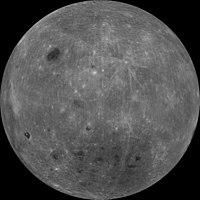The Moon (Latin: Luna) is Earth's only natural satellite and the fifth largest natural satellite in the Solar System.
The average centre-to-centre distance from the Earth to the Moon is 384,403 km, about thirty times the diameter of the Earth. The Moon's diameter is 3,474 km,[6] a little more than a quarter that of the Earth. Thus, the Moon's volume is about 2 percent that of Earth; the pull of gravity at its surface is about 17 percent that at the Earth's surface. The Moon makes a complete orbit around the Earth every 27.3 days (the orbital period), and the periodic variations in the geometry of the Earth–Moon–Sun system are responsible for the lunar phases that repeat every 29.5 days (the synodic period).
The Moon is the only celestial body to which humans have travelled and upon which humans have performed a manned moon landing. The first artificial object to escape Earth's gravity and pass near the Moon was the Soviet Union's Luna 1, the first artificial object to impact the lunar surface was Luna 2, and the first photographs of the normally occluded far side of the Moon were made by Luna 3, all in 1959. The first spacecraft to perform a successful lunar soft landing was Luna 9; this was soon followed with the first successful lunar soft landing by Surveyor 1 and the first unmanned vehicle to orbit the Moon by Luna 10, all in 1966.[6] The United States (U.S.) Apollo program achieved the only manned missions to date, resulting in six landings between 1969 and 1972. Human exploration of the Moon ceased with the conclusion of the Apollo program, although a few robotic landers and orbiters have been sent to the Moon since that time. Several countries have announced plans to return humans to the surface of the Moon in the 2020s.
Name and etymology
The proper English name for Earth's natural satellite is, simply, the Moon (capitalized).[7][8] Moon is a Germanic word, related to the Latin mensis (month). It is ultimately a derivative of the Proto-Indo-European root me-, also represented in measure[9] (time), with reminders of its importance in measuring time in words derived from it like Monday, month and menstrual. The related adjective is lunar, as well as an adjectival prefix seleno- and suffix -selene (from selēnē, the Ancient Greek word for the Moon). In English, the word moon exclusively meant "the Moon" until 1665, when it was extended to refer to the recently-discovered natural satellites of other planets.[9] Subsequently, these objects were given distinct names in order to avoid confusion.[8] The Moon is occasionally referred to by its Latin name Luna, primarily in science fiction.
Lunar surface
Two sides of the Moon
The Moon is in synchronous rotation, meaning that it keeps nearly the same face turned towards the Earth at all times. Early in the Moon's history, its rotation slowed and became locked in this configuration as a result of frictional effects associated with tidal deformations caused by the Earth.[10]
Long ago when the Moon spun much faster, its tidal bulge preceded the Earth-Moon line because the non-fluid crust could not rapidly adjust to keep this bulge in a direct line facing Earth.[11] The Moon's rotation swept the bulge beyond the Earth-Moon line. The pull of gravity on the out-of-line bulge caused a torque, slowing the Moon spin, like a wrench tightening a nut. When the Moon's spin slowed enough to match its orbital rate, then the bulge always faced Earth (the bulge was in line with Earth), and the torque disappeared. That is why the Moon rotates at the same rate as it orbits and we always see the same side of the Moon.
Small variations (libration) in the angle from which the Moon is seen allow about 59% of its surface to be seen from the earth (but only half at any instant).[6]
 |  | |
| Near side of the Moon | Far side of the Moon |
The side of the Moon that faces Earth is called the near side, and the opposite side the far side. The far side is often inaccurately called the "dark side," but in fact, it is illuminated exactly as often as the near side: once per lunar day, during the new moon phase we observe on Earth when the near side is dark. The far side of the Moon was first photographed by the Soviet probe Luna 3 in 1959. One distinguishing feature of the far side is its almost complete lack of maria.

Tidak ada komentar:
Posting Komentar